
Auray is a commune in the Morbihan department, administrative region of Brittany, northwestern France.
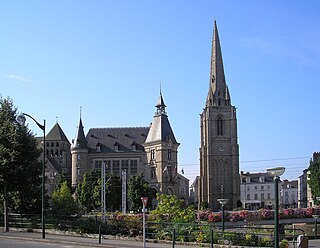
Redon is a commune in the Ille-et-Vilaine department in Brittany in northwestern France. It is a sub-prefecture of the department.
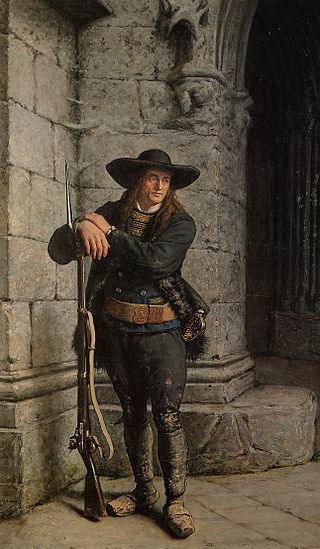
Chouan is a French nickname. It was used as a nom de guerre by the Chouan brothers, most notably Jean Cottereau, better known as Jean Chouan, who led a major revolt in Bas-Maine against the French Revolution. Participants in this revolt – and to some extent French anti-revolutionary activists in general – came to be known as Chouans, and the revolt itself came to be known as the Chouannerie.

The Chouannerie was a royalist uprising or counter-revolution in twelve of the western départements of France, particularly in the provinces of Brittany and Maine, against the First Republic during the French Revolution. It played out in three phases and lasted from spring 1794 to 1800. The revolt was comparable to the War in the Vendée, which took place in the Vendée region.

Île-d'Arz is an archipelago of nine islands and a commune in the Morbihan department, Brittany, northwestern France, only 6 kilometres to the southwest of Vannes.
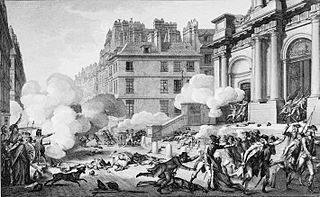
13 Vendémiaire, Year 4 in the French Republican Calendar, is the name given to a battle between the French Revolutionary troops and Royalist forces in the streets of Paris. This battle was part of the establishing of a new form of government, the Directory, and it was a major factor in the rapid advancement of Republican General Napoleon Bonaparte's career.
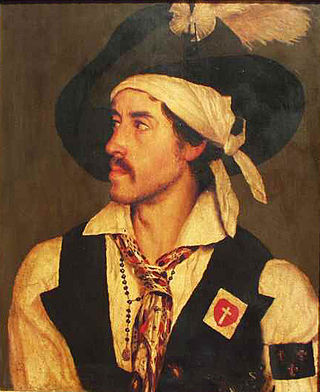
Jean Cottereau, better known by his nom de guerre Jean Chouan, was a French royalist and counter-revolutionary during the Chouannerie.

Bignan is a commune in the Morbihan department in Brittany in northwestern France.

Elven is a commune, located in the department of Morbihan and region of Brittany, western France.

The Catholic and Royal Armies is the name given to the royalist armies in western France composed of insurgents during the war in the Vendée and the Chouannerie, who opposed the French Revolution.

The invasion of France was a major landing on the Quiberon peninsula by émigré, counter-revolutionary troops in support of the Chouannerie and Vendée Revolt, beginning on 23 June and finally definitively repulsed on 21 July. It aimed to raise the whole of western France in revolt, bring an end to the French Revolution and restore the French monarchy. The invasion failed; it had a major negative impact, dealing a disastrous blow to the royalist cause.

Aimé Casimir Marie Picquet, chevalier du Boisguy, sometimes spelt Bois-Guy,, was a Breton chouan general during the French Revolution. He was nicknamed "the little general" by his men due to his youth. Still a child at the outbreak of the Revolution, he signalled his precocity to fight on the Royalist side, joining the Breton Association at 15 and becoming aide de camp to La Rouërie. At 17 he was made leader of the chouannerie in the pays de Fougères, and a general at 19. Boisguy made the north-east of the Ille-et-Vilaine one of the most active areas of the Breton chouannerie, and showed himself an excellent tactician. Rarely beaten, the chouans there were among the best organised and best disciplined. Fighting in uniform from the end of 1795 and made up of elite troops, even so they suffered from a lack of cavalry and a near-total lack of artillery. The Republicans had to raise major forces to defeat them, and then only with difficulty. In both 1796 and 1800, Boisguy was the last general to surrender, making him one of the main figures of the chouannerie.

The Chouan Army of Rennes and Fougères was a royalist counter-revolutionary army that operated in the 1790s in revolutionary France. The army was founded in 1794 as part of the Catholic and Royal Army of Brittany, but split from it under its leader Lieutenant General Joseph de Puisaye in 1795. The army was made up of people active in the Chouannerie revolts.

The Battle of Savenay took place on 23 December 1793, and marks the end of the Virée de Galerne operational phase of the first war in the Vendée after the French Revolution. A Republican force of approximately 18,000 decisively defeated the Armée Catholique et Royale force of 6,000 at Savenay.
Henri Victor Roulland, or Rouland was a French Brigadier General of the French Revolution and the French Revolutionary Wars. He led the heroic defense of the fortress of Landrecies during the Siege of Landrecies (1794), but was forced to surrender after a devastating artillery bombardment that lasted three days.

The Chapel of the Madeleine, formerly the Priory of the Madeleine or Malestroit Priory, is a ruined chapel in Malestroit in the department of Morbihan, Brittany, France.
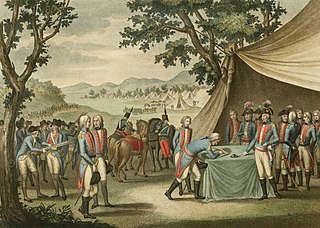
The Treaty of La Jaunaye was a peace treaty for the War in the Vendée, agreed by François de Charette and Charles Sapinaud de La Rairie, on behalf of the leaders of the Catholic and Royal Army, and by Albert Ruelle on behalf of the National Convention on 17 February 1795 at the manor of La Jaunaye, at Saint-Sébastien-sur-Loire, near Nantes.

The Battle of the Tombettes took place in 1800, between the Chouans and the Republicans during the Chouannerie.

The Saint-Sauveur Abbey Church is a Catholic church situated in Redon, in the French department of Ille-et-Vilaine, in the Brittany region. The church is located to the north of the former Saint-Sauveur Abbey of Redon, where it served as the abbey church until 1790. At that time, the abbey was suppressed, and the church was then assigned to the parish. The monastic buildings subsequently became a high school.

The Battle of Redon, fought on June 4, 1815, was a significant clash during the Chouannerie of 1815, where the royalist Chouan forces led by Louis de Sol de Grisolles attacked the town of Redon. Despite their numerical advantage of 4,000–5,000 troops against a small Imperial garrison of 120 men, the Chouans could not capture the town due to their lack of artillery and withdrew after intense fighting.




















